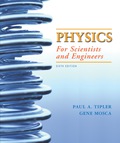
Concept explainers
(a)
To Calculate:The orbital period of the space craft.
(a)
Answer to Problem 57P
Explanation of Solution
Given data:
Mass of the spacecraft,
Formula Used:
From Kepler’s third law, the square of the period
Here,
Calculation:
The height of the spacecraft is
Here,
Substitute
From Kepler’s third law, the square of the period
Here,
Substitute
Thus, the expression for the period of the spacecraft’s orbit about the Earth is,
Substitute the values and solve:
Conclusion:
The orbital period of te space craft is
(b)
The kinetic energy of the spacecraft
(b)
Answer to Problem 57P
Explanation of Solution
Given data:
Mass of the spacecraft,
Formula used:
The kinetic energy of the spacecraft is
Here,
The orbital velocity of the spacecraft is expressed as follows:
Calculation:
Substitute
Substitute the values:
Conclusion:
The kinetic energy of the spacecraft is
(c)
The
(c)
Answer to Problem 57P
Explanation of Solution
Given data:
Mass of the spacecraft,
Formula used:
The moment of inertia of the space craft is
Calculation:
Substitute the values and solve:
The angular momentum of the spacecraft in terms of kinetic energy is
Substitute the values:
Conclusion:
The angular momentum of the spacecraft is
Want to see more full solutions like this?
Chapter 11 Solutions
EBK PHYSICS FOR SCIENTISTS AND ENGINEER
- Check Your Understanding By what factor must the radius change to reduce the orbital velocity of a satellite by one-half? By what factor would this change the period?arrow_forwardCircular orbits in Equation 13.10 for conic sections must have eccentricity zero. From this, and using Newton’s second law applied to centripeta acceleration, show that the value of in Equation 13.10 is given by Where is the angular momentum of the orbiting body. The value of is constant and given by this expression regardless of the type of orbit.arrow_forwardThe Sun’s mass is 2.01030kg , its radius is 7.0105km , and it has a rotational period of approximately 28 days. If the Sun should collapse into a white dwarf of radius 3.5103km , what would its period be if no mass were ejected and a sphere of uniform density can model the Sun both before and after?arrow_forward
- Check Your Understanding Which has greater angular momentum: a solid sphere of mass m rotating at a constant angular frequency 0 about the z-axis, or a solid cylinder of same mass and rotation rate about the z-axis?arrow_forwardA satellite in a geosynchronous circular orbit is 42,164.0 km from the center of Earth. A small asteroid collides with the satellite sending it into an elliptical orbit of apogee 45,000.0 km. What is the speed of the satellite at apogee? Assume its angular momentum is conserved.arrow_forwardA Molniya orbit is a highly eccentric orbit of a communication satellite so as to provide continuous communications coverage for Scandinavian countries and adjacent Russia. The orbit is positioned so that these countries have the satellite in view for extended periods in time (see below). If a satellite in such an orbit has an apogee at 40,000.0 km as measured from the center of Earth and a velocity of 3.0 km/s, what would be its velocity at perigee measured at 200.0 km altitude?arrow_forward
- Check Your Understanding A top has a precession frequency of 5.0 rad/s on Earth. What is its precession frequency on the Moon?arrow_forwardUsing Figure 13.9, carefull sketch a free body diagram for the case of a simple pendulum hanging at latitude lambda, labeling all forces acting on the point mass,m. Set up the equations of motion for equilibrium, setting one coordinate in the direction of the centripetal accleration (toward P in the diagram), the other perpendicular to that. Show that the deflection angle , defined as the angle between the pendulum string and the radial direction toward the center of Earth, is given by the expression below. What is the deflection angle at latitude 45 degrees? Assume that Earth is a perfect sphere. tan(+)=gg2REtan , where is the angular velocity of Earth.arrow_forwardCheck Your Understanding Assume you are in a spacecraft in orbit about the Sun at Earth’s orbit, but far away from Earth (so that it can be ignored). How could you redirect your tangential velocity to the radial direction such that you could then pass by Mars’s orbit? What would be required to change just the direction of the velocity?arrow_forward
- A weather satellite is to be placed in a circular orbit around the earth at an altitude of 300 miles. Itsinitial velocity in orbit is parallel to the earth's surface. What should this initial velocity be?(Hint: Get the value of acceleration due to gravity, g at the initial position of the satellite, but notconsidering the effect of the earth's rotation.)arrow_forwardConsider an asteroid with a radius of 17 km and a mass of 3.8×1015 kg. Assume the asteroid is roughly spherical. What is the acceleration due to gravity on the surface of the asteroid? Suppose the asteroid spins about an axis through its center, like the Earth, with a rotational period T .What is the smallest value T can have before loose rocks on the asteroid's equator begin to fly off the surface? (Answer: T = # h)arrow_forwardCalculate the angular momentum of a 205 kg motorcycle traveling at 40 m/s, and traveling around a circular curve 600 m in radius.arrow_forward
 Principles of Physics: A Calculus-Based TextPhysicsISBN:9781133104261Author:Raymond A. Serway, John W. JewettPublisher:Cengage Learning
Principles of Physics: A Calculus-Based TextPhysicsISBN:9781133104261Author:Raymond A. Serway, John W. JewettPublisher:Cengage Learning Classical Dynamics of Particles and SystemsPhysicsISBN:9780534408961Author:Stephen T. Thornton, Jerry B. MarionPublisher:Cengage Learning
Classical Dynamics of Particles and SystemsPhysicsISBN:9780534408961Author:Stephen T. Thornton, Jerry B. MarionPublisher:Cengage Learning University Physics Volume 1PhysicsISBN:9781938168277Author:William Moebs, Samuel J. Ling, Jeff SannyPublisher:OpenStax - Rice University
University Physics Volume 1PhysicsISBN:9781938168277Author:William Moebs, Samuel J. Ling, Jeff SannyPublisher:OpenStax - Rice University Modern PhysicsPhysicsISBN:9781111794378Author:Raymond A. Serway, Clement J. Moses, Curt A. MoyerPublisher:Cengage Learning
Modern PhysicsPhysicsISBN:9781111794378Author:Raymond A. Serway, Clement J. Moses, Curt A. MoyerPublisher:Cengage Learning Glencoe Physics: Principles and Problems, Student...PhysicsISBN:9780078807213Author:Paul W. ZitzewitzPublisher:Glencoe/McGraw-Hill
Glencoe Physics: Principles and Problems, Student...PhysicsISBN:9780078807213Author:Paul W. ZitzewitzPublisher:Glencoe/McGraw-Hill




